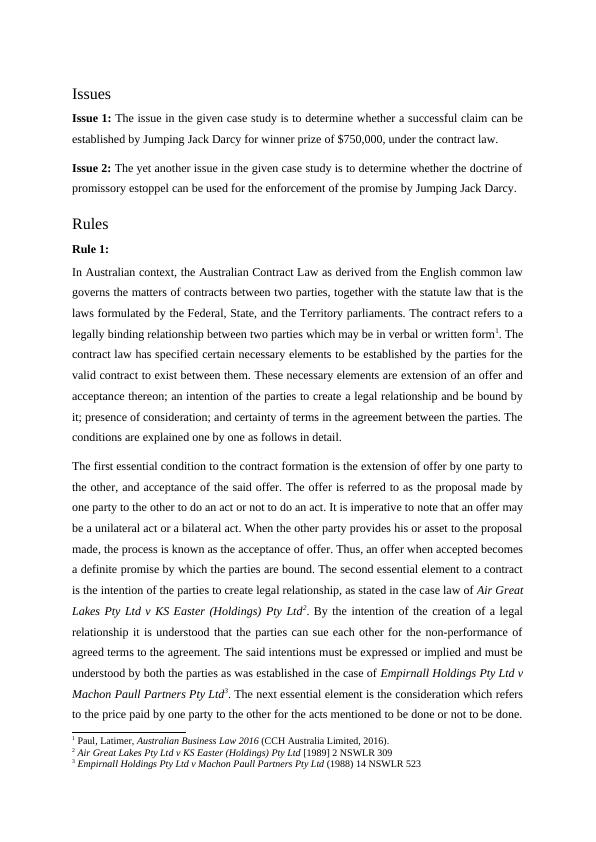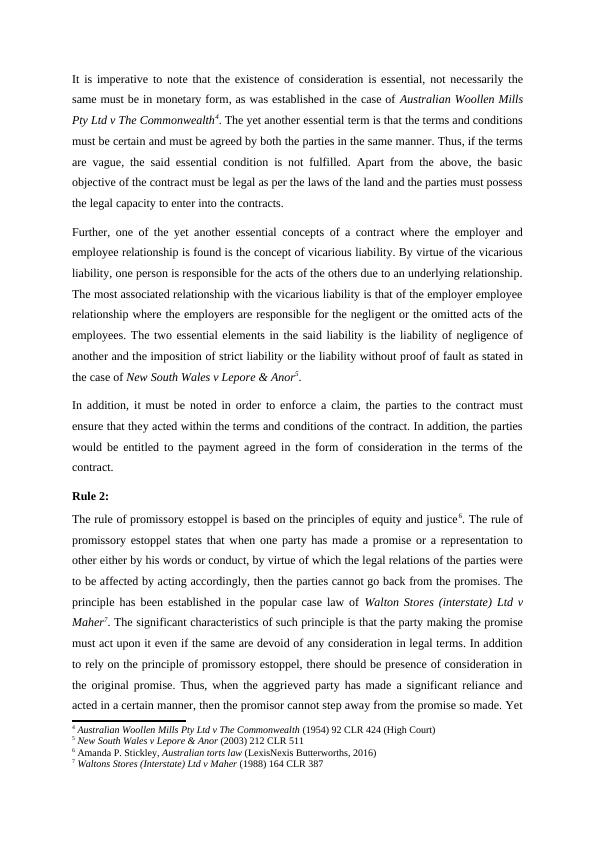Contract Law and Promissory Estoppel in Australian Context
Added on 2022-11-28
6 Pages1977 Words428 Views
LAW

Issues
Issue 1: The issue in the given case study is to determine whether a successful claim can be
established by Jumping Jack Darcy for winner prize of $750,000, under the contract law.
Issue 2: The yet another issue in the given case study is to determine whether the doctrine of
promissory estoppel can be used for the enforcement of the promise by Jumping Jack Darcy.
Rules
Rule 1:
In Australian context, the Australian Contract Law as derived from the English common law
governs the matters of contracts between two parties, together with the statute law that is the
laws formulated by the Federal, State, and the Territory parliaments. The contract refers to a
legally binding relationship between two parties which may be in verbal or written form1. The
contract law has specified certain necessary elements to be established by the parties for the
valid contract to exist between them. These necessary elements are extension of an offer and
acceptance thereon; an intention of the parties to create a legal relationship and be bound by
it; presence of consideration; and certainty of terms in the agreement between the parties. The
conditions are explained one by one as follows in detail.
The first essential condition to the contract formation is the extension of offer by one party to
the other, and acceptance of the said offer. The offer is referred to as the proposal made by
one party to the other to do an act or not to do an act. It is imperative to note that an offer may
be a unilateral act or a bilateral act. When the other party provides his or asset to the proposal
made, the process is known as the acceptance of offer. Thus, an offer when accepted becomes
a definite promise by which the parties are bound. The second essential element to a contract
is the intention of the parties to create legal relationship, as stated in the case law of Air Great
Lakes Pty Ltd v KS Easter (Holdings) Pty Ltd2. By the intention of the creation of a legal
relationship it is understood that the parties can sue each other for the non-performance of
agreed terms to the agreement. The said intentions must be expressed or implied and must be
understood by both the parties as was established in the case of Empirnall Holdings Pty Ltd v
Machon Paull Partners Pty Ltd3. The next essential element is the consideration which refers
to the price paid by one party to the other for the acts mentioned to be done or not to be done.
1 Paul, Latimer, Australian Business Law 2016 (CCH Australia Limited, 2016).
2 Air Great Lakes Pty Ltd v KS Easter (Holdings) Pty Ltd [1989] 2 NSWLR 309
3 Empirnall Holdings Pty Ltd v Machon Paull Partners Pty Ltd (1988) 14 NSWLR 523
Issue 1: The issue in the given case study is to determine whether a successful claim can be
established by Jumping Jack Darcy for winner prize of $750,000, under the contract law.
Issue 2: The yet another issue in the given case study is to determine whether the doctrine of
promissory estoppel can be used for the enforcement of the promise by Jumping Jack Darcy.
Rules
Rule 1:
In Australian context, the Australian Contract Law as derived from the English common law
governs the matters of contracts between two parties, together with the statute law that is the
laws formulated by the Federal, State, and the Territory parliaments. The contract refers to a
legally binding relationship between two parties which may be in verbal or written form1. The
contract law has specified certain necessary elements to be established by the parties for the
valid contract to exist between them. These necessary elements are extension of an offer and
acceptance thereon; an intention of the parties to create a legal relationship and be bound by
it; presence of consideration; and certainty of terms in the agreement between the parties. The
conditions are explained one by one as follows in detail.
The first essential condition to the contract formation is the extension of offer by one party to
the other, and acceptance of the said offer. The offer is referred to as the proposal made by
one party to the other to do an act or not to do an act. It is imperative to note that an offer may
be a unilateral act or a bilateral act. When the other party provides his or asset to the proposal
made, the process is known as the acceptance of offer. Thus, an offer when accepted becomes
a definite promise by which the parties are bound. The second essential element to a contract
is the intention of the parties to create legal relationship, as stated in the case law of Air Great
Lakes Pty Ltd v KS Easter (Holdings) Pty Ltd2. By the intention of the creation of a legal
relationship it is understood that the parties can sue each other for the non-performance of
agreed terms to the agreement. The said intentions must be expressed or implied and must be
understood by both the parties as was established in the case of Empirnall Holdings Pty Ltd v
Machon Paull Partners Pty Ltd3. The next essential element is the consideration which refers
to the price paid by one party to the other for the acts mentioned to be done or not to be done.
1 Paul, Latimer, Australian Business Law 2016 (CCH Australia Limited, 2016).
2 Air Great Lakes Pty Ltd v KS Easter (Holdings) Pty Ltd [1989] 2 NSWLR 309
3 Empirnall Holdings Pty Ltd v Machon Paull Partners Pty Ltd (1988) 14 NSWLR 523

It is imperative to note that the existence of consideration is essential, not necessarily the
same must be in monetary form, as was established in the case of Australian Woollen Mills
Pty Ltd v The Commonwealth4. The yet another essential term is that the terms and conditions
must be certain and must be agreed by both the parties in the same manner. Thus, if the terms
are vague, the said essential condition is not fulfilled. Apart from the above, the basic
objective of the contract must be legal as per the laws of the land and the parties must possess
the legal capacity to enter into the contracts.
Further, one of the yet another essential concepts of a contract where the employer and
employee relationship is found is the concept of vicarious liability. By virtue of the vicarious
liability, one person is responsible for the acts of the others due to an underlying relationship.
The most associated relationship with the vicarious liability is that of the employer employee
relationship where the employers are responsible for the negligent or the omitted acts of the
employees. The two essential elements in the said liability is the liability of negligence of
another and the imposition of strict liability or the liability without proof of fault as stated in
the case of New South Wales v Lepore & Anor5.
In addition, it must be noted in order to enforce a claim, the parties to the contract must
ensure that they acted within the terms and conditions of the contract. In addition, the parties
would be entitled to the payment agreed in the form of consideration in the terms of the
contract.
Rule 2:
The rule of promissory estoppel is based on the principles of equity and justice6. The rule of
promissory estoppel states that when one party has made a promise or a representation to
other either by his words or conduct, by virtue of which the legal relations of the parties were
to be affected by acting accordingly, then the parties cannot go back from the promises. The
principle has been established in the popular case law of Walton Stores (interstate) Ltd v
Maher7. The significant characteristics of such principle is that the party making the promise
must act upon it even if the same are devoid of any consideration in legal terms. In addition
to rely on the principle of promissory estoppel, there should be presence of consideration in
the original promise. Thus, when the aggrieved party has made a significant reliance and
acted in a certain manner, then the promisor cannot step away from the promise so made. Yet
4 Australian Woollen Mills Pty Ltd v The Commonwealth (1954) 92 CLR 424 (High Court)
5 New South Wales v Lepore & Anor (2003) 212 CLR 511
6 Amanda P. Stickley, Australian torts law (LexisNexis Butterworths, 2016)
7 Waltons Stores (Interstate) Ltd v Maher (1988) 164 CLR 387
same must be in monetary form, as was established in the case of Australian Woollen Mills
Pty Ltd v The Commonwealth4. The yet another essential term is that the terms and conditions
must be certain and must be agreed by both the parties in the same manner. Thus, if the terms
are vague, the said essential condition is not fulfilled. Apart from the above, the basic
objective of the contract must be legal as per the laws of the land and the parties must possess
the legal capacity to enter into the contracts.
Further, one of the yet another essential concepts of a contract where the employer and
employee relationship is found is the concept of vicarious liability. By virtue of the vicarious
liability, one person is responsible for the acts of the others due to an underlying relationship.
The most associated relationship with the vicarious liability is that of the employer employee
relationship where the employers are responsible for the negligent or the omitted acts of the
employees. The two essential elements in the said liability is the liability of negligence of
another and the imposition of strict liability or the liability without proof of fault as stated in
the case of New South Wales v Lepore & Anor5.
In addition, it must be noted in order to enforce a claim, the parties to the contract must
ensure that they acted within the terms and conditions of the contract. In addition, the parties
would be entitled to the payment agreed in the form of consideration in the terms of the
contract.
Rule 2:
The rule of promissory estoppel is based on the principles of equity and justice6. The rule of
promissory estoppel states that when one party has made a promise or a representation to
other either by his words or conduct, by virtue of which the legal relations of the parties were
to be affected by acting accordingly, then the parties cannot go back from the promises. The
principle has been established in the popular case law of Walton Stores (interstate) Ltd v
Maher7. The significant characteristics of such principle is that the party making the promise
must act upon it even if the same are devoid of any consideration in legal terms. In addition
to rely on the principle of promissory estoppel, there should be presence of consideration in
the original promise. Thus, when the aggrieved party has made a significant reliance and
acted in a certain manner, then the promisor cannot step away from the promise so made. Yet
4 Australian Woollen Mills Pty Ltd v The Commonwealth (1954) 92 CLR 424 (High Court)
5 New South Wales v Lepore & Anor (2003) 212 CLR 511
6 Amanda P. Stickley, Australian torts law (LexisNexis Butterworths, 2016)
7 Waltons Stores (Interstate) Ltd v Maher (1988) 164 CLR 387

End of preview
Want to access all the pages? Upload your documents or become a member.
Related Documents
Contract Law: Validity of Contract and Promissory Estoppellg...
|8
|2197
|132
Business Law Issue Solution Assesmentlg...
|7
|2009
|24
Law Project: Contract Law and Promissory Estoppellg...
|9
|2298
|280
Business Law Assignmentlg...
|8
|1988
|208
Validity and Payment in Contract Lawlg...
|6
|1492
|74
Business Law Assignmentlg...
|9
|1919
|166
